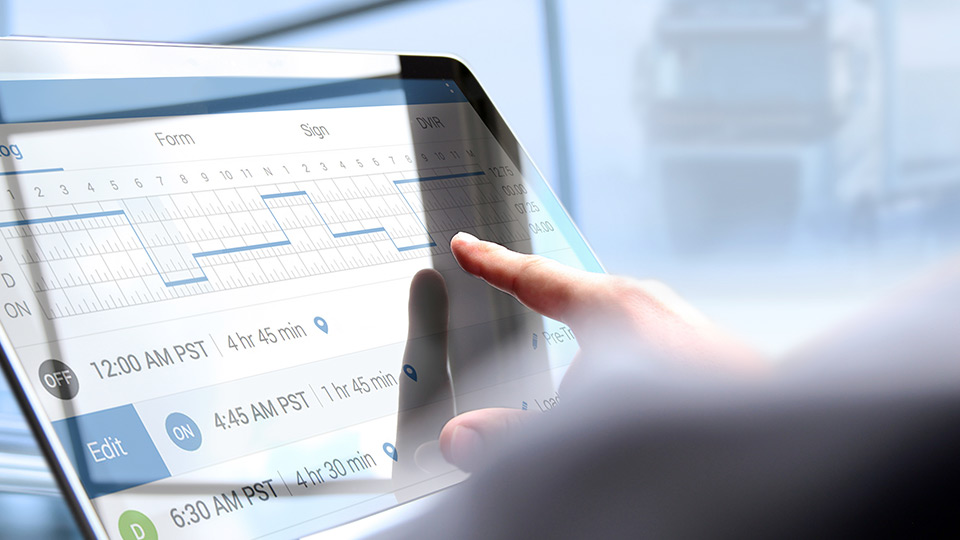
FMCSA revises Hours of Service Final Rule: What you need to know
Last updated on March 2, 2022 in Compliance by Kyle Dodsworth | 3 minute read
Table of contents
What do the Final Rule changes mean for drivers and managers?
On September 29, 2020, the FMCSA Final Rule changes will take effect. The Hours of Service regulations are being revised to provide greater flexibility and increased safety.
Here is what you need to know to ensure your fleet is compliant:
What is changing in the Hours of Service Final Rule?
The changes to the Final Rule include:
- An increase in safety and flexibility for the 30-minute break rule by requiring a break after 8 hours of consecutive driving and allowing the break to be satisfied by a driver using ON-duty, not driving status, rather than OFF-duty status
- Modification to the sleeper-berth exception to allow drivers to split their required 10 hours off-duty into two periods: an 8/2 split, or a 7/3 split — with neither period counting against the driver’s 14‑hour driving window
- Modification of the adverse driving conditions exception through extending by two hours the maximum window during which driving is permitted
- The short-haul exception available to certain commercial drivers will change by lengthening the drivers maximum on‑duty period from 12 to 14 hours and extending the distance limit within which the driver may operate from 100 air miles to 150 air miles
For more information, check out the FMCSA's Fact Sheet here.
How does this affect Geotab Drive users?
There are very few changes to view within the Geotab Drive application. Functionally, the changes relate to how the relevant rulesets calculate availability.
Geotab has added the changes to the relevant rulesets in advance of the deadline. On September 29, drivers will automatically notice the following changes in the system.
- The Break countdown used on USA Property Rulesets will be using Drive time instead of Workday time, and any status that is not Driving will reset the timer if it's more than 30 minutes
- The short haul ruleset will upgrade to 14hrs Workday instead of 12
- Using Adverse Weather will modify both workday/duty time and Drive time on all USA Federal Rulesets
See also: Your guide to Hours of Service (U.S.)
The current USA Property Rulesets (all variations) will no longer support Sleeper Berth split calculations. Geotab has created new USA Property Rulesets with Split Sleeper in order to support the more flexible Sleeper Options in the Final Rule. These new rulesets will be available on September 28, 2020, one day before the Final Rule goes into effect.
By September 29, drivers who utilize Sleeper Split will be required to switch to the new USA Property ruleset option that includes “with Split Sleeper.” If the Ruleset name does not include “with Split Sleeper,” it will not calculate Sleeper Split availability.
Example:
For a driver using the ruleset USA Property 60-hour/7-day (16-hour exemption) who wants to useSplit Sleeper rules, they should change it to USA Property 60-hour/7-day with split sleeper (16-hour exemption.)
What actions need to be taken?
If your drivers use Sleeper Berth Split provisions, they will need to change rulesets to one of the USA Property Rulesets denoted “with Split Sleeper” in order to have correct availability shown during use of split sleeper.
If your drivers do not use Sleeper Berth Split provisions for Property carrying, there is no action to take. On September 29, the availability shown to drivers will reflect the new Break, Adverse Driving and Short Haul limits where applicable.
Changes for drivers
Drivers who have the ability to change their rulesets can select them from the ruleset list accessible on the HOS tab of the Geotab Drive App.
To switch rulesets, tap the Pencil icon next to your current ruleset, select your new ruleset on the next screen and press Done.
.png)
Changes for administrators
Drivers who do not have the ability to change rulesets will need to have them changed by their support personnel using the MyGeotab Portal, under the Drivers HOS setting in their User Profile. For a walkthrough of setting up Drivers, watch our YouTube video: How to add a driver in MyGeotab.
User settings can also be updated in bulk if you need to change a large number of drivers. For a guide to edit user settings in bulk, watch: How to mass edit users in MyGeotab.
To make it easy for drivers to switch between Rulesets with Sleeper Split and those without, Geotab recommends adding our customizable Ruleset Switcher Add-In from the Marketplace.
If desired, vehicles can also be configured to not display the Sleeper Berth option (for cases where they are not equipped, or should not be used.) This setting can be found in the Vehicle Edit page under More details.
.png)
Conclusion
Drivers may switch between a ruleset that includes the Sleeper Split and one that does not at any time, and the availability shown in the Geotab Drive application will reflect the respective choice. It is anticipated that drivers will routinely switch based on their needs.
Keep in mind, Geotab rulesets will always help maximize a driver’s workday, based on the Records of Duty Status (RODS) available. This means that a ruleset denoted as “with Split Sleeper” will always assume the driver is utilizing the Split option. It is important that drivers complete their Sleeper Splits correctly when they run low on availability.
Please subscribe to our blog for updates and enhancements to this feature in the coming release.
If you liked this post, let us know!
Disclaimer
Geotab's blog posts are intended to provide information and encourage discussion on topics of interest to the telematics community at large. Geotab is not providing technical, professional or legal advice through these blog posts. While every effort has been made to ensure the information in this blog post is timely and accurate, errors and omissions may occur, and the information presented here may become out-of-date with the passage of time.
Get industry tips and insights
Sign up for monthly news and tips from our award-winning fleet management blog. You can unsubscribe at any time.
Republish this article for free
Other posts you might like

Electronic logs: unlocking the benefits for trucking
April 15, 2024

Electronic Logbooks: Mandates, Compliance, & Implementation
April 15, 2024

ELD self-certification: What you need to know
April 10, 2024

The Impact of the California Clean Truck Check on Your Fleet
March 27, 2024






